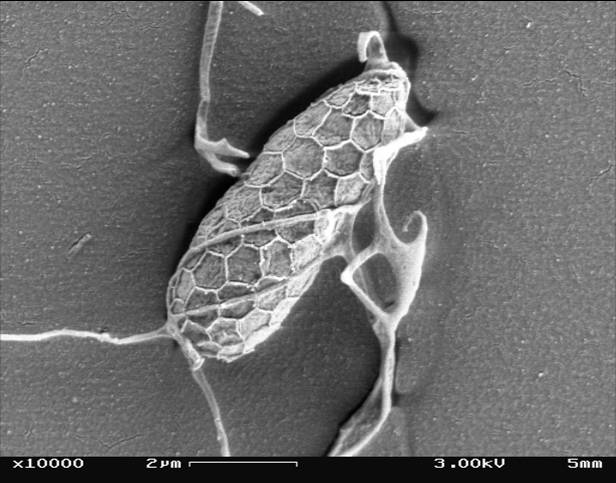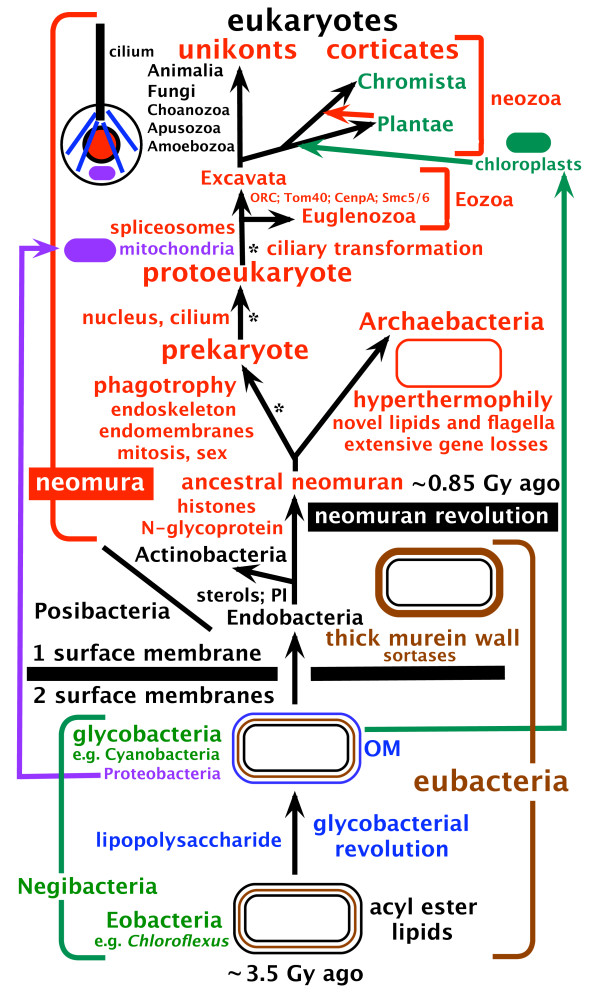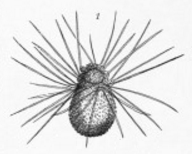|
Heterokonta
The stramenopiles, also called heterokonts, are protists distinguished by the presence of stiff tripartite external hairs. In most species, the hairs are attached to flagella, in some they are attached to other areas of the cellular surface, and in some they have been secondarily lost (in which case relatedness to stramenopile ancestors is evident from other shared cytological features or from genetic similarity). Stramenopiles represent one of the three major clades in the SAR supergroup, along with Alveolata and Rhizaria. Stramenopiles are eukaryotes; most are single-celled, but some are multicellular including some large seaweeds, the brown algae. The group includes a variety of algal protists, heterotrophic flagellates, opalines and closely related proteromonad flagellates (all endobionts in other organisms); the actinophryid Heliozoa, and oomycetes. The tripartite hairs characteristic of the group have been lost in some of the included taxa – for example in most di ... [...More Info...] [...Related Items...] OR: [Wikipedia] [Google] [Baidu] |
Yellow-green Algae
Yellow-green algae or the Xanthophyceae (xanthophytes) are an important group of heterokont algae. Most live in fresh water, but some are found in marine and soil habitats. They vary from single-celled flagellates to simple colonial and filamentous forms. Xanthophyte chloroplasts contain the photosynthetic pigments chlorophyll ''a'', chlorophyll ''c'', β-carotene, and the carotenoid diadinoxanthin. Unlike other Stramenopiles (heterokonts), their chloroplasts do not contain fucoxanthin, which accounts for their lighter colour. Their storage polysaccharide is chrysolaminarin. Xanthophyte cell walls are produced of cellulose and hemicellulose. They appear to be the closest relatives of the brown algae. Classifications The species now placed in the Xanthophyceae were formerly included in the Chlorophyceae. In 1899, Lüther created the group Heterokontae for green algae with unequal flagella. Pascher (1914) included the Heterokontae in the Chrysophyta. In 1930, Allorge renamed t ... [...More Info...] [...Related Items...] OR: [Wikipedia] [Google] [Baidu] |
Ochrophyte
Ochrophytes, also known as heterokontophytes or stramenochromes, are a phylum of algae. They are the photosynthetic stramenopiles, a group of eukaryotes, organisms with a cell nucleus, characterized by the presence of two unequal flagella, one of which has tripartite hairs called mastigonemes. In particular, they are characterized by photosynthetic organelles or plastids enclosed by four membranes, with membrane-bound compartments called thylakoids organized in piles of three, chlorophyll ''a'' and ''c'' as their photosynthetic pigments, and additional pigments such as β-carotene and xanthophylls. Ochrophytes are one of the most diverse lineages of eukaryotes, containing ecologically important algae such as brown algae and diatoms. They are classified either as phylum Ochrophyta, Heterokontophyta or as subphylum Ochrophytina withing phylum Gyrista. Their plastids are of red algal origin. Description Ochrophytes are eukaryotic organisms composed of cells that are eithe ... [...More Info...] [...Related Items...] OR: [Wikipedia] [Google] [Baidu] |
Flagella
A flagellum (; : flagella) (Latin for 'whip' or 'scourge') is a hair-like appendage that protrudes from certain plant and animal sperm cells, from fungal spores ( zoospores), and from a wide range of microorganisms to provide motility. Many protists with flagella are known as flagellates. A microorganism may have from one to many flagella. A gram-negative bacterium '' Helicobacter pylori'', for example, uses its flagella to propel itself through the stomach to reach the mucous lining where it may colonise the epithelium and potentially cause gastritis, and ulcers – a risk factor for stomach cancer. In some swarming bacteria, the flagellum can also function as a sensory organelle, being sensitive to wetness outside the cell. Across the three domains of Bacteria, Archaea, and Eukaryota, the flagellum has a different structure, protein composition, and mechanism of propulsion but shares the same function of providing motility. The Latin word means " whip" to describe its ... [...More Info...] [...Related Items...] OR: [Wikipedia] [Google] [Baidu] |
Bigyra
Bigyra () is a phylum of microscopic eukaryotes that are found at the base of the Stramenopiles clade. It includes three well-known heterotrophic groups Bicosoecida, Opalinata and Labyrinthulomycetes, as well as several small clades initially discovered through environmental DNA samples: Nanomonadea, Placididea, Opalomonadea and Eogyrea. The classification of Bigyra has changed several times since its origin, and its monophyly remains unresolved. Ecological diversity Bigyra is a diverse group of heterotrophic, mainly phagotrophic stramenopiles that lack cell walls. It contains three well-known important groups with widely different ecological functions and morphologies: labyrinthulomycetes, opalines and bicosoecids. Labyrinthulomycetes is a group of protists that absorb nutrients in an osmotrophic or phagotrophic manner. They can behave either as free-living amoebae or as mycelium-like networks of cytoplasmic threads. Some of them are saprotrophic decomposers of the detritus, de ... [...More Info...] [...Related Items...] OR: [Wikipedia] [Google] [Baidu] |
Gyrista
Gyrista is a clade of stramenopile protists containing three diverse groups: the mostly photosynthetic Ochrophyta, the parasitic Pseudofungi, and the recently described group of nanoflagellates known as Bigyromonada. Members of this phylum are characterized by the presence of a helix or a double helix/ring system in the ciliary transition region. Systematics Taxonomic history Gyrista was first described in 1998 by protistologist Thomas Cavalier-Smith in his work ''A revised six-kingdom system of life'', originally as a superphylum containing two phyla: Ochrophyta, the heterokont algae; and Bigyra, which then contained the pseudofungi and bigyromonads together with the opalines. Later, the name Bigyra was modified to contain opalines, bicosoecids and labyrinthulomycetes, while the Ochrophyta, Pseudofungi and Bigyromonada remained as groups within Gyrista. Molecular phylogenetics Gyrista was seen in 2017 as the sister group to phylum Bigyra, which contains the Sag ... [...More Info...] [...Related Items...] OR: [Wikipedia] [Google] [Baidu] |
Oomycete
The Oomycetes (), or Oomycota, form a distinct phylogenetic lineage of fungus-like eukaryotic microorganisms within the Stramenopiles. They are filamentous and heterotrophic, and can reproduce both sexually and asexually. Sexual reproduction of an oospore is the result of contact between hyphae of male antheridia and female oogonia; these spores can overwinter and are known as resting spores. Asexual reproduction involves the formation of chlamydospores and sporangia, producing motile zoospores. Oomycetes occupy both saprophytic and pathogenic lifestyles, and include some of the most notorious pathogens of plants, causing devastating diseases such as late blight of potato and sudden oak death. One oomycete, the mycoparasite '' Pythium oligandrum'', is used for biocontrol, attacking plant pathogenic fungi. The oomycetes are also often referred to as water molds (or water moulds), although the water-preferring nature which led to that name is not true of most species, whi ... [...More Info...] [...Related Items...] OR: [Wikipedia] [Google] [Baidu] |
Cavalier-Smith
Thomas (Tom) Cavalier-Smith, Royal Society, FRS, Royal Society of Canada, FRSC, Natural Environment Research Council, NERC Professorial Fellow (21 October 1942 – 19 March 2021), was a professor of evolutionary biology in the Department of Zoology, at the University of Oxford. His research has led to discovery of a number of unicellular organisms (protists) and advocated for a variety of major taxonomic groups, such as the Chromista, Chromalveolata, Opisthokonta, Rhizaria, and Excavata. He was known for Cavalier-Smith's system of classification, his systems of classification of all organisms. Life and career Cavalier-Smith was born on 21 October 1942 in London. His parents were Mary Maude (née Bratt) and Alan Hailes Spencer Cavalier Smith. He was educated at Norwich School (educational institution), Norwich School, Gonville and Caius College, Cambridge (MA) in Biology and King's College London (PhD) in Zoology. He was under the supervision of John Randall (phys ... [...More Info...] [...Related Items...] OR: [Wikipedia] [Google] [Baidu] |
SAR Supergroup
SAR is a highly diverse clade of eukaryotes, often considered a supergroup, that includes stramenopiles (heterokonts), alveolates, and rhizarians. It is a node-based taxon (under the Sar name), including all descendants of the three groups' last common ancestor, and comprises most of the now-rejected Chromalveolata. Their sister group has been found to be telonemids, with which they make up the TSAR clade. Harosa is sometimes used synonymously with TSAR. Etymology The name SAR is an acronym derived from the first letters of its three constituent clades; it has been alternatively spelled RAS. The term Harosa (at the subkingdom level) has also been used, with Stramenopiles replaced by its synonym Heterokonta in this variant of the acronym. History of discovery Before the discovery of the SAR supergroup, stramenopiles and alveolates were classified in the supergroup Chromalveolata alongside haptophytes and cryptomonads, being believed to have acquired plastids th ... [...More Info...] [...Related Items...] OR: [Wikipedia] [Google] [Baidu] |
Kelp
Kelps are large brown algae or seaweeds that make up the order (biology), order Laminariales. There are about 30 different genus, genera. Despite its appearance and use of photosynthesis in chloroplasts, kelp is technically not a plant but a stramenopile (a group containing many protists). Kelp grow from stalks close together in kelp forest, very dense areas like forests under shallow temperate and Arctic oceans. They were previously thought to have appeared in the Miocene, 5 to 23 million years ago based on fossils from California. New fossils of kelp holdfasts from early Oligocene rocks in Washington State show that kelps were present in the northeastern Pacific Ocean by at least 32 million years ago. The organisms require nutrient-rich water with temperatures between . They are known for their high growth rate—the genera ''Macrocystis'' and ''Nereocystis'' can grow as fast as half a metre a day (that is, about 20 inches a day), ultimately reaching .Thomas, D. 2002. ''Seaweed ... [...More Info...] [...Related Items...] OR: [Wikipedia] [Google] [Baidu] |
Sagenista
Sagenista is a group of heterokonts containing the labyrinthulids and Eogyrea, a class of yet uncultured protists. Originally, it contained the Labyrinthulids and bicosoecids. The bicosoecids have been removed, and Eogyrea were added, in order to make the group monophyletic. Some have a special organelle In cell biology, an organelle is a specialized subunit, usually within a cell (biology), cell, that has a specific function. The name ''organelle'' comes from the idea that these structures are parts of cells, as Organ (anatomy), organs are to th ... called a bothrosome (or sagenogenetosome). It is usually found in a marine environments rich in algae and sea grass. It is capable of movement by use of this organelle. They are generally decomposers. They are cultivated for their active production of Omega-3 fatty acids. These acids are used as an approved additive for animal feed. There is a debate about whether some species of Sagenista contain the photosynthetic pigme ... [...More Info...] [...Related Items...] OR: [Wikipedia] [Google] [Baidu] |
Protist
A protist ( ) or protoctist is any eukaryotic organism that is not an animal, land plant, or fungus. Protists do not form a natural group, or clade, but are a paraphyletic grouping of all descendants of the last eukaryotic common ancestor excluding land plants, animals, and fungi. Protists were historically regarded as a separate taxonomic kingdom known as Protista or Protoctista. With the advent of phylogenetic analysis and electron microscopy studies, the use of Protista as a formal taxon was gradually abandoned. In modern classifications, protists are spread across several eukaryotic clades called supergroups, such as Archaeplastida ( photoautotrophs that includes land plants), SAR, Obazoa (which includes fungi and animals), Amoebozoa and " Excavata". Protists represent an extremely large genetic and ecological diversity in all environments, including extreme habitats. Their diversity, larger than for all other eukaryotes, has only been discovered in rece ... [...More Info...] [...Related Items...] OR: [Wikipedia] [Google] [Baidu] |






